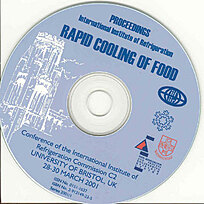
IIR document
Effect of cooling conditions on weight loss of cooked meat during slow air and air blast cooling processes.
Author(s) : WANG L. J., SUN D. W.
Summary
Weight loss of cooked meat during slow air cooling processes is affected by the cooling conditions such as air velocity, air temperature and relative humidity. Weight loss has been theoretically analysed by an experimentally validated finite element model. The results show that for cooling a large block of cooked meat from the core temperature of 74 to 5 °C (maximum temperature) by air blast cooling method, air velocity has little effect on the total weight loss. The total weight loss increases significantly with the decrease in relative humidity of the air. If the relative humidity is reduced from 92 to 65%, the total weight loss will be increased by 20%. Lower air temperatures produce fast cooling at the surface and thus lower the weight loss greatly. However, air temperature below 0 °C may freeze the surface of the product. The results also show that most of the weight loss occurs at the beginning of the cooling process due to high surface temperature. Therefore, low air temperature can initially be used to accelerate the decrease of the surface temperature near to the freezing point of water, and a higher air temperature can then be used to avoid surface freezing of the products.
Available documents
Format PDF
Pages: 2001-1
Available
Public price
20 €
Member price*
Free
* Best rate depending on membership category (see the detailed benefits of individual and corporate memberships).
Details
- Original title: Effect of cooling conditions on weight loss of cooked meat during slow air and air blast cooling processes.
- Record ID : 2005-1356
- Languages: English
- Source: Rapid Cooling of Food.
- Publication date: 2001/03/28
Links
See other articles from the proceedings (41)
See the conference proceedings
Indexing
-
Themes:
Meat and meat products;
Precooked food - Keywords: Velocity (fluids, gases); Meat; Chilling; Research; Air; Cooked food; Meat product; Weight loss; Parameter
-
Basic phenomena and consequences.
- Author(s) : KONDJOYAN A.
- Date : 1996/10
- Languages : English
- Source: New Developments in Meat Refrigeration.
- Formats : PDF
View record
-
Analysis of cooling performance of slow air, ai...
- Author(s) : WANG L. J., SUN D. W.
- Date : 2001/03/28
- Languages : English
- Source: Rapid Cooling of Food.
- Formats : PDF
View record
-
Simulation of vacuum cooling process of cooked ...
- Author(s) : WANG L. J., SUN D. W.
- Date : 2001/03/28
- Languages : English
- Source: Rapid Cooling of Food.
- Formats : PDF
View record
-
Measurement of water activity of cured-cooked p...
- Author(s) : DELGADO A. E., SUN D. W.
- Date : 2001/03/28
- Languages : English
- Source: Rapid Cooling of Food.
- Formats : PDF
View record
-
Air flow characteristics in a chiller for pork ...
- Author(s) : DAUDIN J. D., BOUTON V., PROD'HOMME G., MOURLHON-DALLIES J. L.
- Date : 1992/08/23
- Languages : English
- Source: 38th International Congress of Meat Science and Technology (ICoMST). Proceedings.
View record
